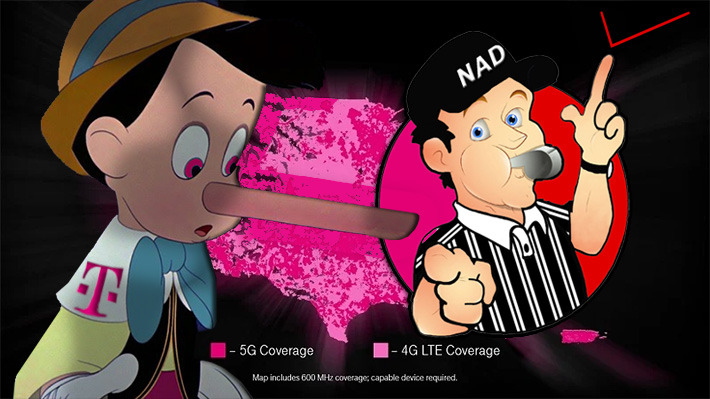
T-Mobile stated that it will appeal NAD’s decision and noted its disappointment with NAD’s conclusions regarding the challenged advertising claims other than NAD’s conclusion concerning its claims regarding superior 5G coverage, and NAD’s conclusion that its 5G is faster than any carrier’s 4G network.
The National Advertising Division (NAD) of BBB National Programs determined that T-Mobile US, Inc. supported claims that its 5G service is faster than a competitors’ 4G, as well as its own 4G, but recommended it discontinue express and implied claims that its 5G network is more reliable than competing 4G or 5G networks. Similarly, NAD determined that T-Mobile supported claims that its 5G service currently provides better coverage than that of competitors, however, NAD recommended that T-Mobile discontinue the challenged claim that its 5G service is generally available in locations that have traditionally been challenging for cellular service (or disclose, clearly and conspicuously, the typical performance of T-Mobile’s 5G).
The claims at issue were challenged by Verizon Communications, Inc., provider of competing wireless services.
NAD also recommended that T-Mobile discontinue product demonstrations that:
- Other carriers’ coverage is so limited in any area as to cover only a single bench; and
- Compare the coverage and performance of Verizon’s 5G to T-Mobile’s 5G in Hard Rock Stadium in Miami shortly before the Super Bowl and the related implied claim that T-Mobile’s current 5G network consistently provides no signal loss, decrease in signal strength, or reversion to 4G LTE service
Further, NAD recommended that T-Mobile modify the execution of an animated coverage map used by T-Mobile in certain advertisements, so that consumers can notice, read, and understand the maps and accompanying legend; and that it clearly and conspicuously disclose any material differences between its network and competing 5G networks when it makes a comparative claim about its 5G coverage.
T-Mobile will appeal NAD’s adverse recommendations to the National Advertising Review Board.
The following are representative of the challenged claims, which were made in internet and television advertising:
Express claims:
- “What’s the difference between 5G and 4G LTE? With 5G, high amounts of data can be transmitted more efficiently than 4G LTE. That means stronger network reliability, faster downloads, and support for more connected devices than ever before. Greater reliability. Enhanced capacity. Faster speeds.”
- “Because T-Mobile’s 5G is built on this low band signal, it can penetrate walls . . . and all that really means is you get a lot better coverage in buildings like this one, or your mom’s basement.”
- “T-Mobile’s 5G works inside and out.”
- “Other carriers have 5G signals that drop if you move two feet.”
- “T-Mobile’s nationwide 5G reaches more people in more places, and no 5G signal is more reliable.”“T-Mobile has the first, largest, and only nationwide 5G network, covering more people and places than anyone else. No 5G signal goes farther or is more reliable.”
Implied claims:
- T-Mobile’s 5G network is faster, better, and more reliable than both its 4G LTE network and its competitors’ 4G LTE and 5G networks.
- T-Mobile’s 5G network will provide a significantly better customer experience to T-Mobile customers than T-Mobile’s 4G LTE network does and its competitors’ 4G LTE and 5G networks do.
- T-Mobile’s current 5G network consistently provides no signal loss, decrease in signal strength, or reversion to 4G LTE service.
NAD determined that the evidence in the record substantiated T-Mobile’s claim that its 5G service is faster than its own 4G and its competitors’ 4G, such as “Each generation gets faster, is more reliable, and every G changed our lives in small and really big ways.” However, NAD noted that the challenged claims also convey a message about metrics other than speed. There was no evidence comparing 5G to 4G on metrics like reliability and metrics that “will change our lives in really big ways,” therefore NAD recommended that T-Mobile modify its claims to more clearly state the metrics like speed for which 5G is superior to 4G.
Further, NAD determined that the challenged advertising reasonably conveys the message that T-Mobile’s 5G typically delivers service in the physical locations shown in the advertising, such as basements and elevators, where cellular customers are accustomed to potentially experiencing a coverage gap. While it was undisputed that T-Mobile’s low band signal can penetrate walls, there was no evidence of the extent to which it does so, or whether it delivers coverage in locations that have traditionally challenged cellular service. Therefore, NAD recommended that T-Mobile discontinue these claims or modify them to disclose, clearly and conspicuously, the typical performance of T-Mobile’s 5G.
With regard to challenged claims regarding T-Mobile’s geographic coverage, NAD determined that that such claims did not convey the implied message that T-Mobile provides the same level of coverage in both urban and rural areas of the country. However, with respect to claims that were tied to an animated coverage map used by T-Mobile in certain advertisements, NAD recommended that the execution of the challenged coverage maps be modified so that consumers can notice, read, and understand the maps and accompanying legend. It was undisputed that T-Mobile’s 4G coverage area is greater than its 5G coverage area. NAD concluded that if consumers were given time to read the legend to the map, and examine the map itself, they would not take away a message of universal 5G coverage because each map, when read in conjunction with the legend, (eventually) shows that T-Mobile’s 5G is available in only part of its coverage area.
Verizon also challenged a demonstration depicting competing 5G service as delivering a coverage area that is barely larger than the bench of a bus stop, as Bill Nye states, “Other carriers have 5G signals that drop if you move two feet” and “This is how far 5G reaches with other carriers.” NAD recommended that T-Mobile discontinue these claims and the accompanying demonstration because there was no evidence that Verizon’s coverage is so limited in any area as to cover only a single bench, and T-Mobile’s disclosure, “A slight exaggeration, other 5G signals can cover whole blocks!” contradicts the main claim and is, therefore, insufficient to cure the misleading message.
With regard to challenged videos comparing Verizon’s 5G to T-Mobile’s 5G in Hard Rock Stadium in Miami shortly before the Super Bowl, NAD determined that T-Mobile did not show that the performance of Verizon that was depicted was typical for Verizon customers and because one of the demonstrations reasonably conveys the implied message that T-Mobile’s current 5G network consistently provides no signal loss, decrease in signal strength, or reversion to 4G LTE service. For these reasons, NAD recommended that T-Mobile discontinue these videos.
NAD considered T-Mobile’s evidence offered in support of express and implied challenged superiority claims that its 5G network provides better coverage and is more reliable than the 5G networks of competing providers. LBNAD determined that T-Mobile provided a reasonable basis for claims regarding better coverage. However, NAD did not accept T-Mobile’s argument that superior coverage means superior reliability. Without reliable evidence in the record on comparative reliability of competing networks, NAD recommended that T-Mobile discontinue the claim that its 5G service is more reliable than its competitors’ 5G.
Finally, NAD determined that the challenged advertisements reasonably convey the message that T-Mobile 5G is better because of its coverage and is otherwise at least comparable to other companies’ 5G service on other metrics like speed, so that T-Mobile provides a better network experience. However, NAD noted that T-Mobile’s and Verizon’s 5G offerings are materially different –T-Mobile has superior availability, while Verizon has superior speeds. Further, there was no evidence in the record that consumers understand the differences in performance metrics between carriers’ 5G services. Therefore, NAD determined that, without a disclosure, the challenged advertising reasonably conveys the message that T-Mobile’s 5G network will provide a better customer experience to T-Mobile customers than its competitors’ 5G networks. NAD recommended that, when T-Mobile makes a comparative claim about its 5G coverage, it clearly and conspicuously disclose any material differences between its network and competing 5G networks.















